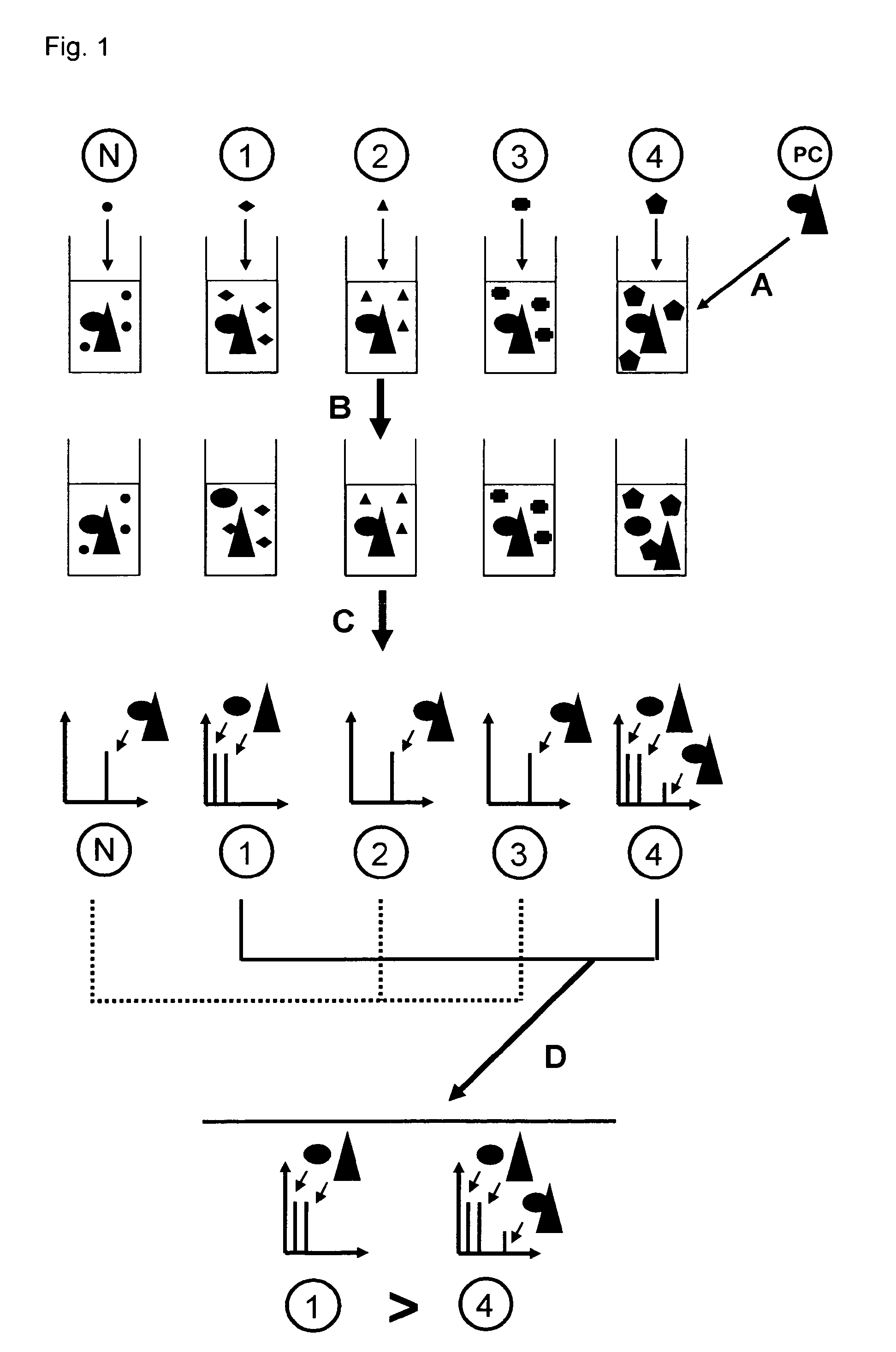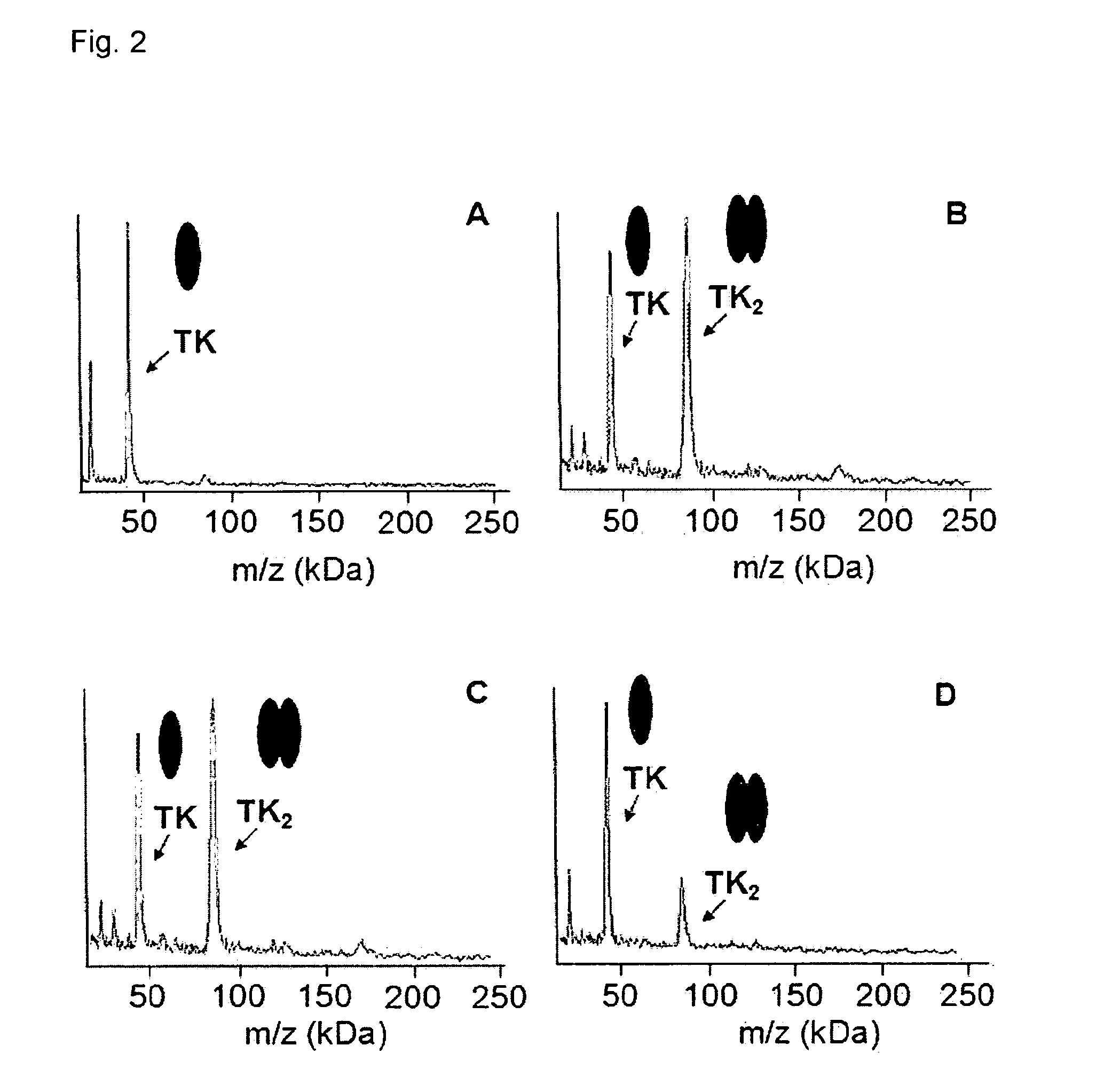Direct mass spectrometric analysis of drug candidates targeting protein complexes
a mass spectrometric and protein complex technology, applied in the field of direct mass spectrometric analysis of drug candidates targeting protein complexes, can solve the problems of time-consuming and labor-intensive complexes using electrospray ionization, and the tendency of non-covalent interactions between proteins to dissociate during the analysis, so as to achieve high throughput
- Summary
- Abstract
- Description
- Claims
- Application Information
AI Technical Summary
Benefits of technology
Problems solved by technology
Method used
Image
Examples
example 1
Use of Chemical Crosslinking and High Mass MALDI Mass Spectrometry for the Determination of the Effect of AG32 on Thymidin Kinase Protein Complex
[0083]AG32 is a drug candidate targeting the enzyme Thymidin Kinase (TK). This drug candidate is belonging to the lamotrigine coumpounds family with a MW of around 400 Da. This enzyme catalyze the transfer of y-phosphate from ATP to the 5′ OH group of thymidine, yielding thymidine monophosphate, a precursor for DNA synthesis in the so-called pyrimidine salvage pathway. This enzyme is essential for a large number of virus pathogenicity, especially for the reactivation of viruses from latency.
[0084]Purified samples of TK are prepared and submitted to cross-linking using a mixture of 1:1:1 disuccinimidyl 3,3′-dithiopropionate, disuccinimidyl glutarate, and octanedioic acid bis(3-sulfo-N-hydroxysuccinimide)ester (100 mg / ml). Before (FIG. 2A) and after incubation at 25° C. for 45 min with the cross-linking reagent, the sample is directly analyze...
example 2
Use of Chemical Cross-Linking and High Mass MALDI Mass Spectrometry for the Determination of the Effect of PK115, PK117 and PK118 on the Protein Complex Tcf4 / β-Catenin
[0085]Key molecular lesions in colorectal and other cancers cause β-catenin-dependant transactivation of T cell factor (Tcf)-dependant genes. Disruption of this signal represents an opportunity for rational cancer therapy. PK115, PK117 and PKF118 are drug candidates coming from a natural compounds library with MW in the 500 Da range that are targeting the interaction Tcf4 / β-catenin. Purified samples of Tcf4 / β-catenin complex are incubated (1 hour, 25° C.) with a negative control molecule (NC) (having similar MW and chemical structure of drug candidates) or with the drug candidates PKF115, PK117 or PK118. After incubation, the samples are submitted to cross-linking using a mixture of 1:1:1 disuccinimidyl 3,3′-dithiopropionate, disuccinimidyl glutarate, and octanedioic acid bis(3-sulfo-N-hydroxysuccinimide)ester (100 μg / ...
example 3
Quantitative Analysis of Nutlin-3a and Nutlin-3b Inhibition of MDM2-p53 Interaction
[0086]MDM2 and p53 are two proteins involved in a major pathway protecting cells from malignant transformation. In response to stress, the cellular level of p53 is elevated by a posttranslational mechanism, leading to cell cycle arrest or apoptosis. Under non-stressed conditions, p53 tightly interact with MDM2 protein. As MDM2 blocks the ability of p53 to induce cell cycle arrest, the interaction MDM2-p53 is considered as a potential target for cancer therapy. Nutlin-3a and Nutlin-3b have been identified as inhibitors of the interaction allowing activation of apoptosis in the cells treated. The IC50 of these two inhibitors have been determined using Surface Plasmon Resonance with respective values of 0.09 μM for Nutlin-3a and 13.6 μM for Nutlin-3b (Vassilev, L. T. et al., Science 403:844-846, 2004). In the following, it is demonstrated how IC50 values of Nutlin-3a and Nutlin-3b inhibition of MDM2-p53 ...
PUM
| Property | Measurement | Unit |
|---|---|---|
| molecular weight | aaaaa | aaaaa |
| mass | aaaaa | aaaaa |
| mass | aaaaa | aaaaa |
Abstract
Description
Claims
Application Information
 Login to View More
Login to View More - R&D
- Intellectual Property
- Life Sciences
- Materials
- Tech Scout
- Unparalleled Data Quality
- Higher Quality Content
- 60% Fewer Hallucinations
Browse by: Latest US Patents, China's latest patents, Technical Efficacy Thesaurus, Application Domain, Technology Topic, Popular Technical Reports.
© 2025 PatSnap. All rights reserved.Legal|Privacy policy|Modern Slavery Act Transparency Statement|Sitemap|About US| Contact US: help@patsnap.com



